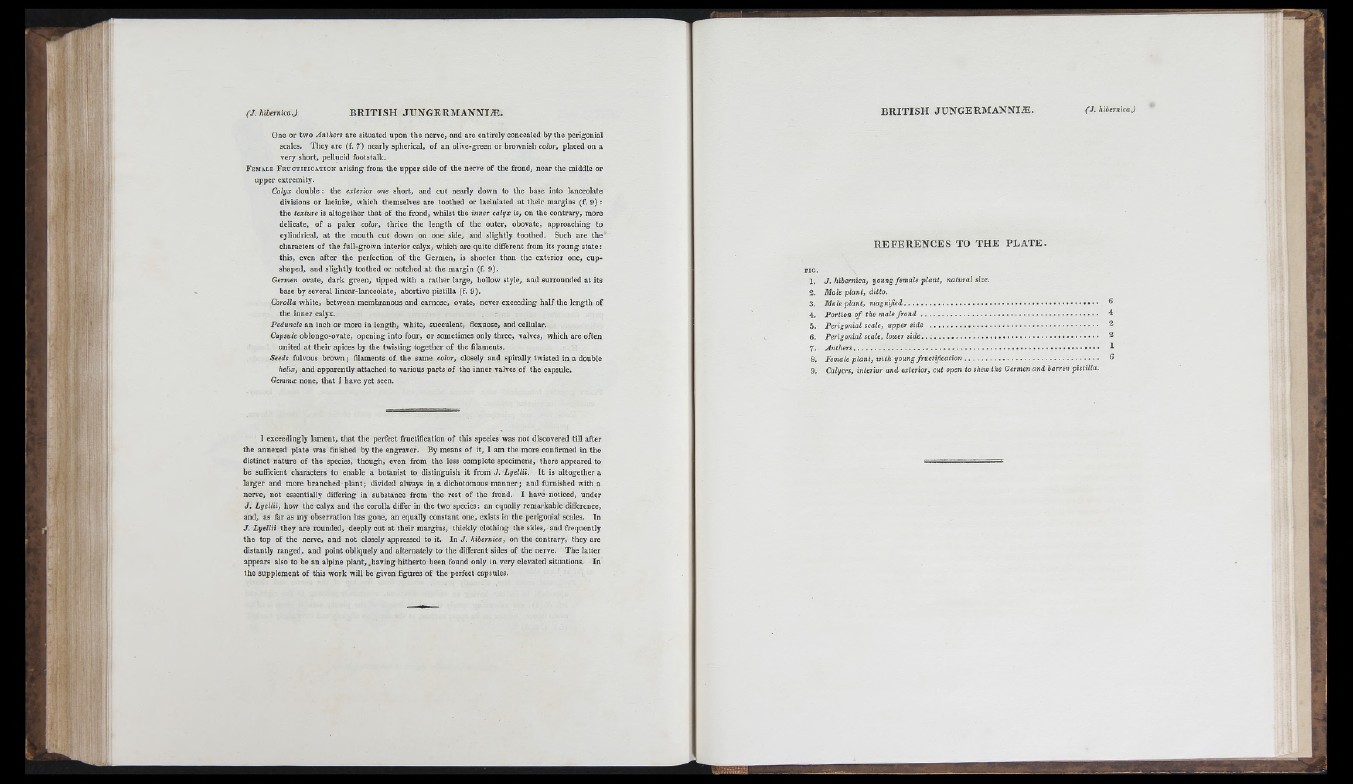
| i |
_ One o r two Anthers are situated upon th e nerve, and are entirely concealed by th e perigonial
scales. They are (f. 7 ) nearly spherical, o f a n olive-green o r brownish color, placed on a
very sh o rt, pellucid footstalk.
F emale Fructification a risin g from the uppe r side o f the nerve o f th e frond, ne a r the middle or
uppe r extremity.
Calyx doable : the exterior one short, and c u t nearly down to the base into lanceolate
divisions or laciniæ, which themselves are toothed or laciniated a t th e ir margins (f. 9 ) :
th e texture is altogether th a t o f the frond, whilst the inner calyx is, on the contrary, more
delicate, o f a p a le r color, thric e th e len g th o f th e outer, obovate, approaching to
cylindrical, a t the mouth c u t down on one side, and slightly toothed. Such a re the
characters o f th e full-grown inte rior calyx, which are q u ite different from its young s ta te :
this, even a fte r the perfection o f th e Germen, is shorter th an th e exterior one, cupshaped,
and slightly toothed o r notched a t the margin (f. 9).
Germen ovate, d a rk g re en , tipped with a ra th e r large, hollow style, and surrounded a t its
base by several linear-lanceolate, abortive pistilla (f. 9).
Corolla white, between membranous and carnose, ovate, never exceeding h a lf the len g th of
the inne r calyx.
Peduncle an inch or more in length, white, succulent, flexuose, and cellular.
Capsule oblongo-ovate, opening info four, o r sometimes only three, valves, which are often
united a t th e ir apices by the twisting together o f th e filaments.
Seeds fulvous b row n ; filaments o f th e same color, closely and spirally twisted in a double
helix, and apparently attached to various pa rts o f the in n e r valves of the capsule.
Gemmce none, th a t I have yet seen.
1 exceedingly lam ent, th a t th e perfect fructification o f this species was not discovered till after
the annexed pla te was finished by th e engraver. By means o f it, I am the more confirmed in the
distinct n a tu re o f th e species, though, even from the less complete specimens, th e re appeared to
be sufficient characters to enable a botanist to distinguish i t from J . LyeUii. I t is a ltoge the r a
la rg e r and more branched p la n t; divided always in a dichotomous m an n e r; and furnished with a
nerve, n ot essentially differing in substance from th e re st o f th e frond. I have noticed, under
J . L y e ilii, how th e calyx and th e corolla differ in the two species : an equally remarkable difference,
and, as far as my observation has gone, a n equally constant one, exists in the perigonial scales. Tn
J . L y e ilii they a re rounded, deeply cu t a t the ir margms, thickly clothing the sides, and frequently
th e top of th e nerve, and n ot closely appressed to it. In J . hibernica, on th e contrary, they are
distantly ranged, and point obliquely and alternately to the different sides of the nerve. T h e la tte r
appears also to be an alpine p la n t,.h a v in g hith e rto been found only in very elevated situations. In
th e supplement of this work will be given figures o f th e perfect capsules.
R E F E R E N C E S T O T H E P L A T E .
J . hibernica, young female p i
Male p la n t, ditto.
Male p la n t, magnified............
Porlion o f the male fro n d . .
Perigonial scale, upper side
Perigonial scale, lower s ide . .
A n th e rs.........................................
Female plant, with young f
Calyces, inteiior and exlerior, cut open to shew the Germen and barren pistilla.